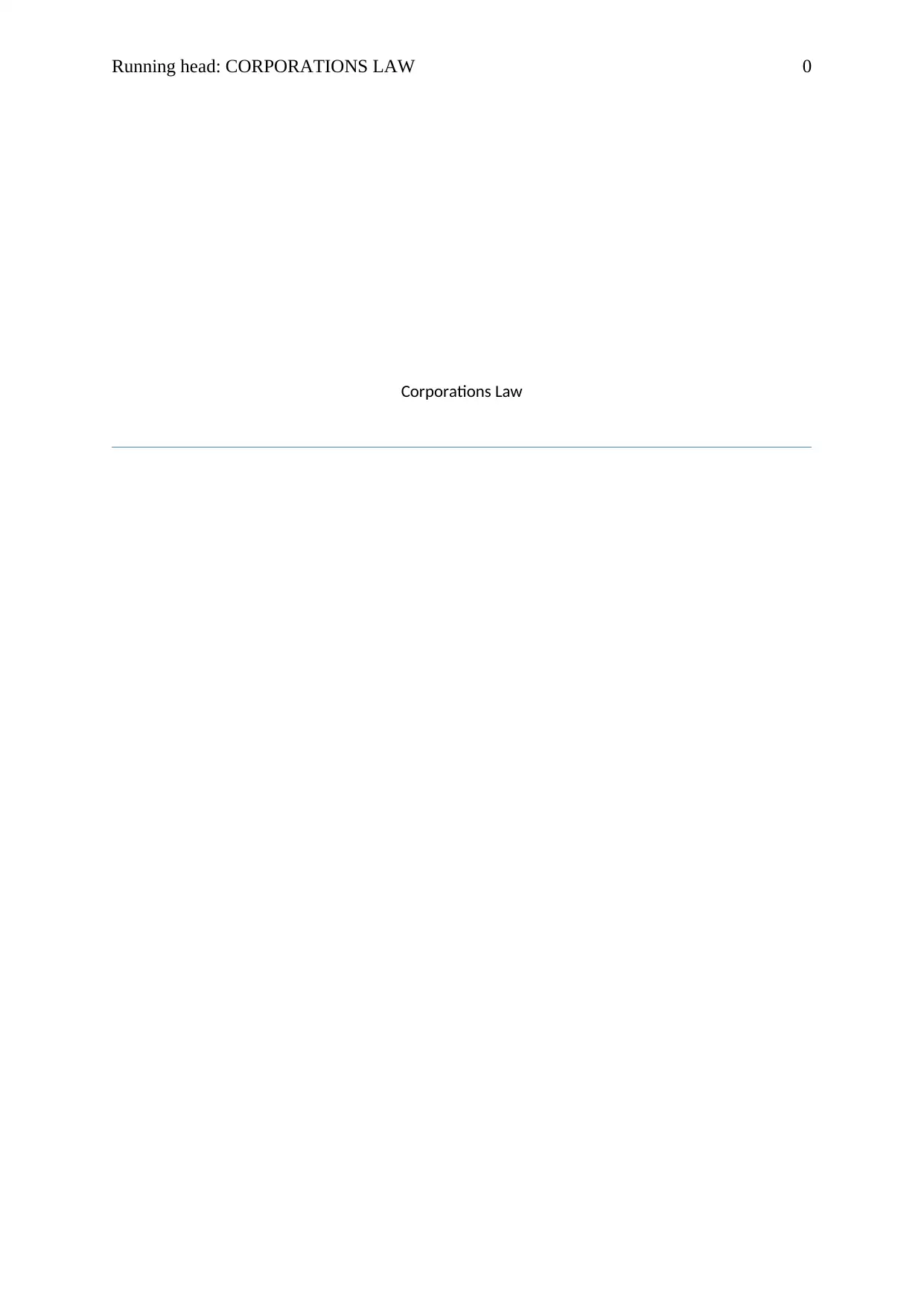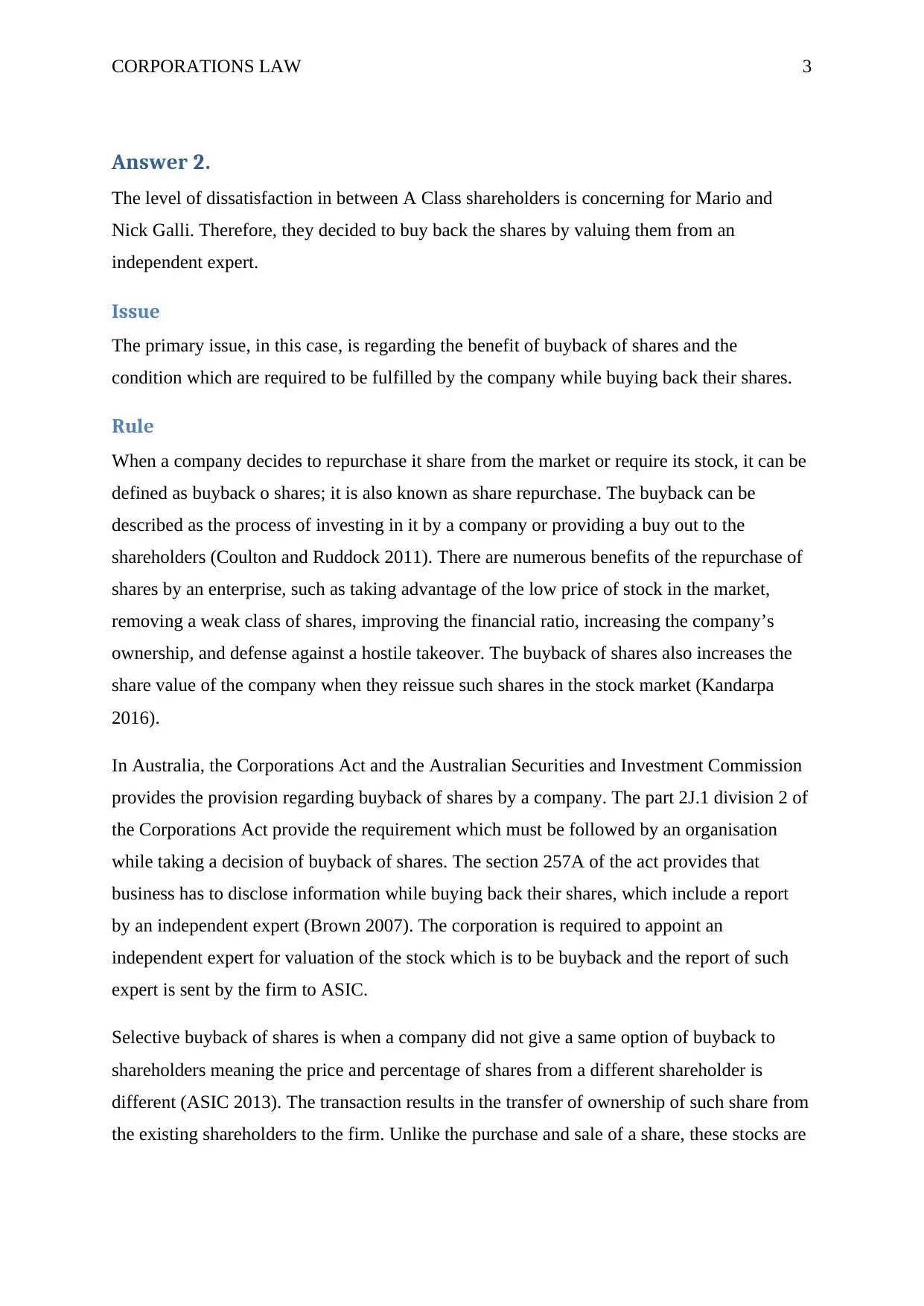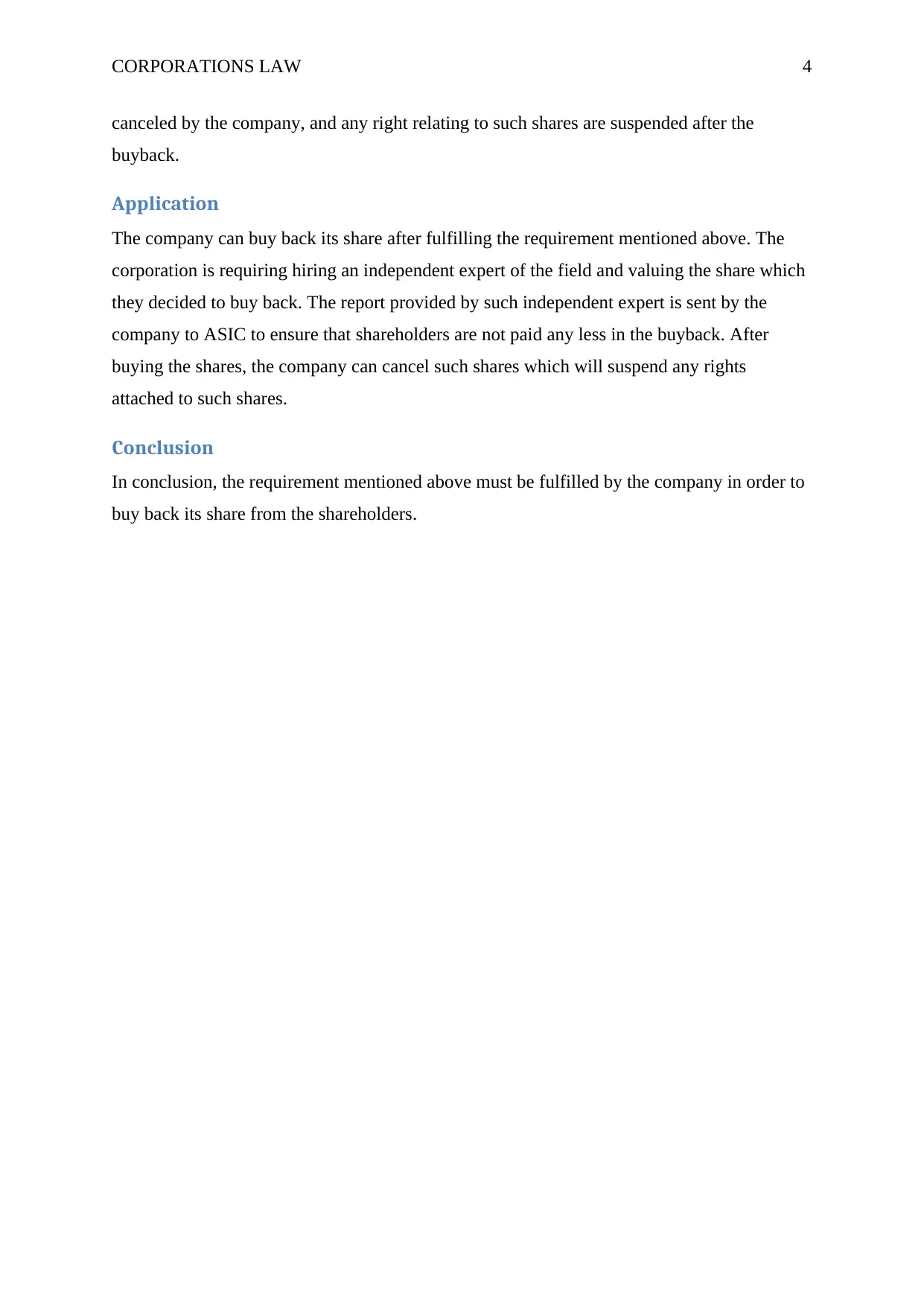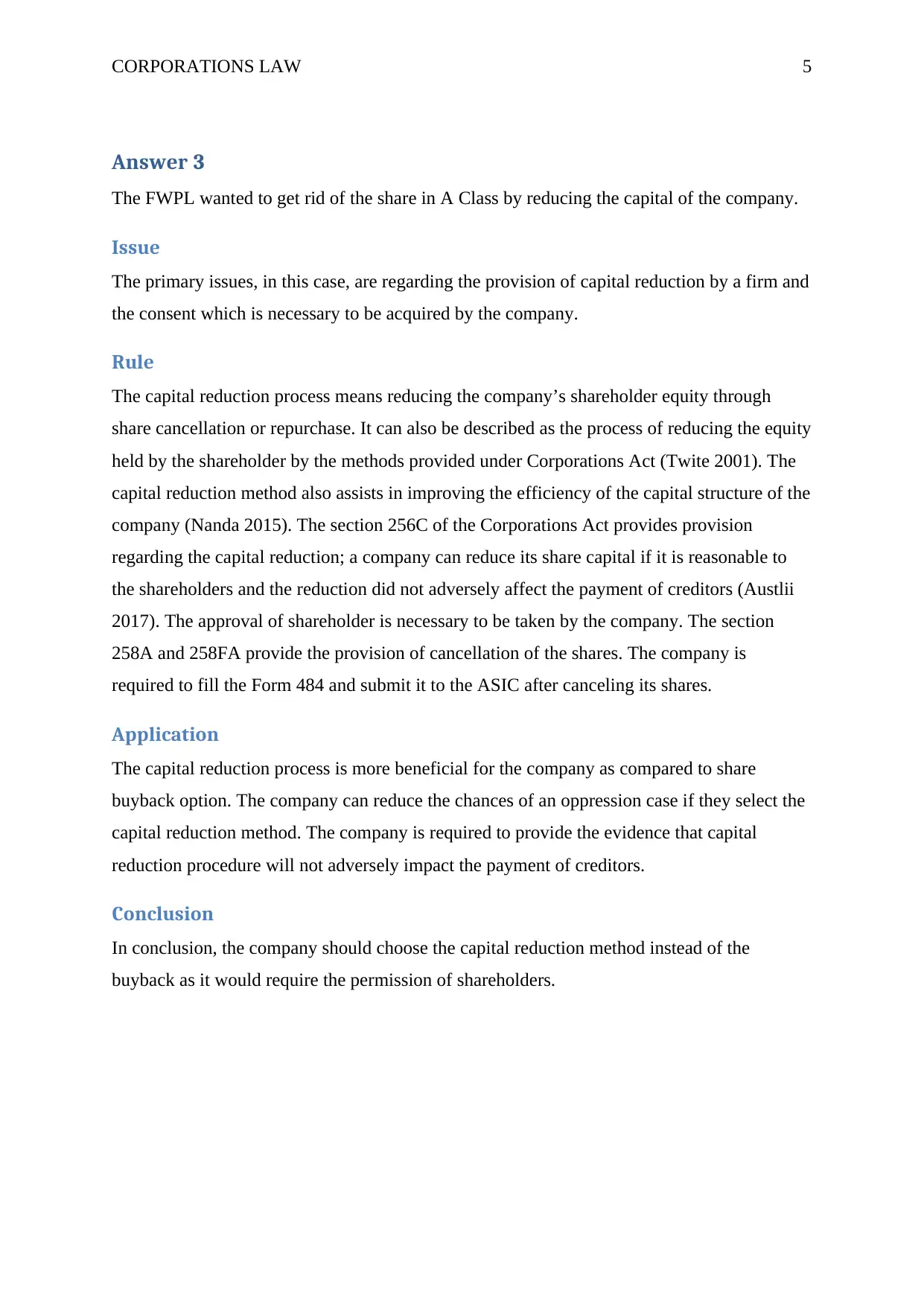Corporations Law Homework: Dividend, Buyback, Capital
VerifiedAdded on 2020/04/29
|7
|1602
|70
Homework Assignment
AI Summary
This assignment delves into key aspects of corporations law, focusing on three main areas: dividend distribution, share buybacks, and capital reduction. The first part examines the rights of shareholders regarding dividend payments and the circumstances under which a company's directors can choose not to distribute dividends, referencing relevant sections of the Corporations Act 2001 and case law such as Thomas v H W Thomas Ltd. The second part explores the process of share buybacks, outlining the benefits for a company, the requirements under the Corporations Act, and the role of independent experts in valuing shares. The final section discusses capital reduction, contrasting it with share buybacks and analyzing the conditions under which a company can reduce its share capital, including the necessary shareholder approvals and the impact on creditors. The assignment provides a comprehensive analysis of these corporate actions, drawing upon legal principles and relevant legislation.

Running head: CORPORATIONS LAW 0
Corporations Law
Corporations Law
Paraphrase This Document
Need a fresh take? Get an instant paraphrase of this document with our AI Paraphraser

CORPORATIONS LAW 1
Answer 1.
As per the constitution of FWPL, the directors take the decision of paying a dividend to A
Class shareholders, which was sufficient for many years. Now, GML did not want to issue
dividend instead they wish to retain their earning for organic vineyard’s development because
Jason was stirring the Galli’s grandchildren, many of which are lazy and undeserving.
Issue
The primary issue is that whether the Galli’s children can take action against the directors’
decision of non-payment of the dividend.
Rule
The shareholders invest in a corporation to earn dividend and increasing their value. As per
the section 254W (2) of Corporations Act, 2001(Cth), the company has right to decide
whether or not they distribute a dividend (Austlii 2017). In order to issue a dividend, the
company is required to have profits, or they have fulfilled the obligations of their creditors.
Section 232 protects the minority shareholder from company’s oppressive conduct. The court
has right to issue remedies against any operative misconduct by the company against its
shareholders in section 233 (Cannavan, Finn and Gray 2004).
The remedies include amending/modifying corporation’s constitution, winding up the order,
buyback of shares, ceasing management from performing any specific action, and enforcing
directors to performing specific actions. In the Thomas v H W Thomas Ltd (1984) 1 NZLR
686 case, the court provided three remedies for the oppressive conduct by a company
(Gardyne 2007). The first condition was that the oppression was unfairly prejudiced
discriminatory against the shareholders. The second term provides that the directors did not
meet the reasonable expectation and the final condition was that providing the remedies is
just and fair for the party.
Application
As per the section 245W (2) of the Corporations Act 2001, the directors have right to decide
whether divided should be distributed or not. In this case, Galli has right to deny the
distribution of dividend to the A Class shareholders. As per the decision provided in Thomas
v H W Thomas Ltd (1984) 1 NZLR 686 case, the court provided three conditions which are
necessary to be fulfilled to constitute a conduct as oppressive. Galli decided to use the profits
Answer 1.
As per the constitution of FWPL, the directors take the decision of paying a dividend to A
Class shareholders, which was sufficient for many years. Now, GML did not want to issue
dividend instead they wish to retain their earning for organic vineyard’s development because
Jason was stirring the Galli’s grandchildren, many of which are lazy and undeserving.
Issue
The primary issue is that whether the Galli’s children can take action against the directors’
decision of non-payment of the dividend.
Rule
The shareholders invest in a corporation to earn dividend and increasing their value. As per
the section 254W (2) of Corporations Act, 2001(Cth), the company has right to decide
whether or not they distribute a dividend (Austlii 2017). In order to issue a dividend, the
company is required to have profits, or they have fulfilled the obligations of their creditors.
Section 232 protects the minority shareholder from company’s oppressive conduct. The court
has right to issue remedies against any operative misconduct by the company against its
shareholders in section 233 (Cannavan, Finn and Gray 2004).
The remedies include amending/modifying corporation’s constitution, winding up the order,
buyback of shares, ceasing management from performing any specific action, and enforcing
directors to performing specific actions. In the Thomas v H W Thomas Ltd (1984) 1 NZLR
686 case, the court provided three remedies for the oppressive conduct by a company
(Gardyne 2007). The first condition was that the oppression was unfairly prejudiced
discriminatory against the shareholders. The second term provides that the directors did not
meet the reasonable expectation and the final condition was that providing the remedies is
just and fair for the party.
Application
As per the section 245W (2) of the Corporations Act 2001, the directors have right to decide
whether divided should be distributed or not. In this case, Galli has right to deny the
distribution of dividend to the A Class shareholders. As per the decision provided in Thomas
v H W Thomas Ltd (1984) 1 NZLR 686 case, the court provided three conditions which are
necessary to be fulfilled to constitute a conduct as oppressive. Galli decided to use the profits

CORPORATIONS LAW 2
to develop the operations of the business also there is lack of any oppressive behavior by the
company. It would be unfair and unjust if the court awards the remedies which are provided
under section 233 of the act.
Conclusion
In conclusion, the non-availability of any oppressive conduct by the company will dismiss the
action taken by the Galli’s grandchildren, and the court cannot force the company to
distribute a dividend.
to develop the operations of the business also there is lack of any oppressive behavior by the
company. It would be unfair and unjust if the court awards the remedies which are provided
under section 233 of the act.
Conclusion
In conclusion, the non-availability of any oppressive conduct by the company will dismiss the
action taken by the Galli’s grandchildren, and the court cannot force the company to
distribute a dividend.
⊘ This is a preview!⊘
Do you want full access?
Subscribe today to unlock all pages.

Trusted by 1+ million students worldwide

CORPORATIONS LAW 3
Answer 2.
The level of dissatisfaction in between A Class shareholders is concerning for Mario and
Nick Galli. Therefore, they decided to buy back the shares by valuing them from an
independent expert.
Issue
The primary issue, in this case, is regarding the benefit of buyback of shares and the
condition which are required to be fulfilled by the company while buying back their shares.
Rule
When a company decides to repurchase it share from the market or require its stock, it can be
defined as buyback o shares; it is also known as share repurchase. The buyback can be
described as the process of investing in it by a company or providing a buy out to the
shareholders (Coulton and Ruddock 2011). There are numerous benefits of the repurchase of
shares by an enterprise, such as taking advantage of the low price of stock in the market,
removing a weak class of shares, improving the financial ratio, increasing the company’s
ownership, and defense against a hostile takeover. The buyback of shares also increases the
share value of the company when they reissue such shares in the stock market (Kandarpa
2016).
In Australia, the Corporations Act and the Australian Securities and Investment Commission
provides the provision regarding buyback of shares by a company. The part 2J.1 division 2 of
the Corporations Act provide the requirement which must be followed by an organisation
while taking a decision of buyback of shares. The section 257A of the act provides that
business has to disclose information while buying back their shares, which include a report
by an independent expert (Brown 2007). The corporation is required to appoint an
independent expert for valuation of the stock which is to be buyback and the report of such
expert is sent by the firm to ASIC.
Selective buyback of shares is when a company did not give a same option of buyback to
shareholders meaning the price and percentage of shares from a different shareholder is
different (ASIC 2013). The transaction results in the transfer of ownership of such share from
the existing shareholders to the firm. Unlike the purchase and sale of a share, these stocks are
Answer 2.
The level of dissatisfaction in between A Class shareholders is concerning for Mario and
Nick Galli. Therefore, they decided to buy back the shares by valuing them from an
independent expert.
Issue
The primary issue, in this case, is regarding the benefit of buyback of shares and the
condition which are required to be fulfilled by the company while buying back their shares.
Rule
When a company decides to repurchase it share from the market or require its stock, it can be
defined as buyback o shares; it is also known as share repurchase. The buyback can be
described as the process of investing in it by a company or providing a buy out to the
shareholders (Coulton and Ruddock 2011). There are numerous benefits of the repurchase of
shares by an enterprise, such as taking advantage of the low price of stock in the market,
removing a weak class of shares, improving the financial ratio, increasing the company’s
ownership, and defense against a hostile takeover. The buyback of shares also increases the
share value of the company when they reissue such shares in the stock market (Kandarpa
2016).
In Australia, the Corporations Act and the Australian Securities and Investment Commission
provides the provision regarding buyback of shares by a company. The part 2J.1 division 2 of
the Corporations Act provide the requirement which must be followed by an organisation
while taking a decision of buyback of shares. The section 257A of the act provides that
business has to disclose information while buying back their shares, which include a report
by an independent expert (Brown 2007). The corporation is required to appoint an
independent expert for valuation of the stock which is to be buyback and the report of such
expert is sent by the firm to ASIC.
Selective buyback of shares is when a company did not give a same option of buyback to
shareholders meaning the price and percentage of shares from a different shareholder is
different (ASIC 2013). The transaction results in the transfer of ownership of such share from
the existing shareholders to the firm. Unlike the purchase and sale of a share, these stocks are
Paraphrase This Document
Need a fresh take? Get an instant paraphrase of this document with our AI Paraphraser

CORPORATIONS LAW 4
canceled by the company, and any right relating to such shares are suspended after the
buyback.
Application
The company can buy back its share after fulfilling the requirement mentioned above. The
corporation is requiring hiring an independent expert of the field and valuing the share which
they decided to buy back. The report provided by such independent expert is sent by the
company to ASIC to ensure that shareholders are not paid any less in the buyback. After
buying the shares, the company can cancel such shares which will suspend any rights
attached to such shares.
Conclusion
In conclusion, the requirement mentioned above must be fulfilled by the company in order to
buy back its share from the shareholders.
canceled by the company, and any right relating to such shares are suspended after the
buyback.
Application
The company can buy back its share after fulfilling the requirement mentioned above. The
corporation is requiring hiring an independent expert of the field and valuing the share which
they decided to buy back. The report provided by such independent expert is sent by the
company to ASIC to ensure that shareholders are not paid any less in the buyback. After
buying the shares, the company can cancel such shares which will suspend any rights
attached to such shares.
Conclusion
In conclusion, the requirement mentioned above must be fulfilled by the company in order to
buy back its share from the shareholders.

CORPORATIONS LAW 5
Answer 3
The FWPL wanted to get rid of the share in A Class by reducing the capital of the company.
Issue
The primary issues, in this case, are regarding the provision of capital reduction by a firm and
the consent which is necessary to be acquired by the company.
Rule
The capital reduction process means reducing the company’s shareholder equity through
share cancellation or repurchase. It can also be described as the process of reducing the equity
held by the shareholder by the methods provided under Corporations Act (Twite 2001). The
capital reduction method also assists in improving the efficiency of the capital structure of the
company (Nanda 2015). The section 256C of the Corporations Act provides provision
regarding the capital reduction; a company can reduce its share capital if it is reasonable to
the shareholders and the reduction did not adversely affect the payment of creditors (Austlii
2017). The approval of shareholder is necessary to be taken by the company. The section
258A and 258FA provide the provision of cancellation of the shares. The company is
required to fill the Form 484 and submit it to the ASIC after canceling its shares.
Application
The capital reduction process is more beneficial for the company as compared to share
buyback option. The company can reduce the chances of an oppression case if they select the
capital reduction method. The company is required to provide the evidence that capital
reduction procedure will not adversely impact the payment of creditors.
Conclusion
In conclusion, the company should choose the capital reduction method instead of the
buyback as it would require the permission of shareholders.
Answer 3
The FWPL wanted to get rid of the share in A Class by reducing the capital of the company.
Issue
The primary issues, in this case, are regarding the provision of capital reduction by a firm and
the consent which is necessary to be acquired by the company.
Rule
The capital reduction process means reducing the company’s shareholder equity through
share cancellation or repurchase. It can also be described as the process of reducing the equity
held by the shareholder by the methods provided under Corporations Act (Twite 2001). The
capital reduction method also assists in improving the efficiency of the capital structure of the
company (Nanda 2015). The section 256C of the Corporations Act provides provision
regarding the capital reduction; a company can reduce its share capital if it is reasonable to
the shareholders and the reduction did not adversely affect the payment of creditors (Austlii
2017). The approval of shareholder is necessary to be taken by the company. The section
258A and 258FA provide the provision of cancellation of the shares. The company is
required to fill the Form 484 and submit it to the ASIC after canceling its shares.
Application
The capital reduction process is more beneficial for the company as compared to share
buyback option. The company can reduce the chances of an oppression case if they select the
capital reduction method. The company is required to provide the evidence that capital
reduction procedure will not adversely impact the payment of creditors.
Conclusion
In conclusion, the company should choose the capital reduction method instead of the
buyback as it would require the permission of shareholders.
⊘ This is a preview!⊘
Do you want full access?
Subscribe today to unlock all pages.

Trusted by 1+ million students worldwide

CORPORATIONS LAW 6
References
ASIC., 2013. Share buy backs. ASIC. Retrieved from <
http://asic.gov.au/for-business/running-a-company/shares/share-buy-backs/ >
Austlii., 2017. Corporations Act 2001 – Sect 254W. Austlii. Retrieved from <
http://www5.austlii.edu.au/au/legis/cth/consol_act/ca2001172/s254w.html >
Austlii., 2017. Corporations Act 2001 – SECT 256C Shareholder approval. Austlii. Retrieved
form < http://www.austlii.edu.au/cgi-bin/viewdoc/au/legis/cth/consol_act/ca2001172/
s256c.html >
Brown, C., 2007. The announcement effects of off-market share repurchases in
Australia. Australian Journal of Management, 32(2), pp.369-385.
Cannavan, D., Finn, F. and Gray, S., 2004. The value of dividend imputation tax credits in
Australia. Journal of Financial Economics, 73(1), pp.167-197.
Coulton, J.J. and Ruddock, C., 2011. Corporate payout policy in Australia and a test of the
life‐cycle theory. Accounting & Finance, 51(2), pp.381-407.
Gardyne, P., 2007. Shareholders-Fiction, Rights, and Remedies. Waikato L. Rev., 15, p.212.
Kandarpa, K., 2016. What is the Purpose of a Share Buyback and How can Shareholders
Benefit from it?. Wise Owl. Retrieved from < https://www.wise-owl.com/investment-
education/what-is-the-purpose-of-a-share-buyback-and-how-can-shareholders-benefit-from-it
>
Nanda, D. S., 2015. Reduction of Share Capital: Analysis. Corporate Law Reporter.
Retrieved form < http://corporatelawreporter.com/2015/02/23/reduction-share-capital-
analysis/ >
Twite, G., 2001. Capital structure choices and taxes: Evidence from the Australian dividend
imputation tax system. International Review of Finance, 2(4), pp.217-234.
References
ASIC., 2013. Share buy backs. ASIC. Retrieved from <
http://asic.gov.au/for-business/running-a-company/shares/share-buy-backs/ >
Austlii., 2017. Corporations Act 2001 – Sect 254W. Austlii. Retrieved from <
http://www5.austlii.edu.au/au/legis/cth/consol_act/ca2001172/s254w.html >
Austlii., 2017. Corporations Act 2001 – SECT 256C Shareholder approval. Austlii. Retrieved
form < http://www.austlii.edu.au/cgi-bin/viewdoc/au/legis/cth/consol_act/ca2001172/
s256c.html >
Brown, C., 2007. The announcement effects of off-market share repurchases in
Australia. Australian Journal of Management, 32(2), pp.369-385.
Cannavan, D., Finn, F. and Gray, S., 2004. The value of dividend imputation tax credits in
Australia. Journal of Financial Economics, 73(1), pp.167-197.
Coulton, J.J. and Ruddock, C., 2011. Corporate payout policy in Australia and a test of the
life‐cycle theory. Accounting & Finance, 51(2), pp.381-407.
Gardyne, P., 2007. Shareholders-Fiction, Rights, and Remedies. Waikato L. Rev., 15, p.212.
Kandarpa, K., 2016. What is the Purpose of a Share Buyback and How can Shareholders
Benefit from it?. Wise Owl. Retrieved from < https://www.wise-owl.com/investment-
education/what-is-the-purpose-of-a-share-buyback-and-how-can-shareholders-benefit-from-it
>
Nanda, D. S., 2015. Reduction of Share Capital: Analysis. Corporate Law Reporter.
Retrieved form < http://corporatelawreporter.com/2015/02/23/reduction-share-capital-
analysis/ >
Twite, G., 2001. Capital structure choices and taxes: Evidence from the Australian dividend
imputation tax system. International Review of Finance, 2(4), pp.217-234.
1 out of 7
Related Documents
Your All-in-One AI-Powered Toolkit for Academic Success.
+13062052269
info@desklib.com
Available 24*7 on WhatsApp / Email
![[object Object]](/_next/static/media/star-bottom.7253800d.svg)
Unlock your academic potential
Copyright © 2020–2025 A2Z Services. All Rights Reserved. Developed and managed by ZUCOL.





